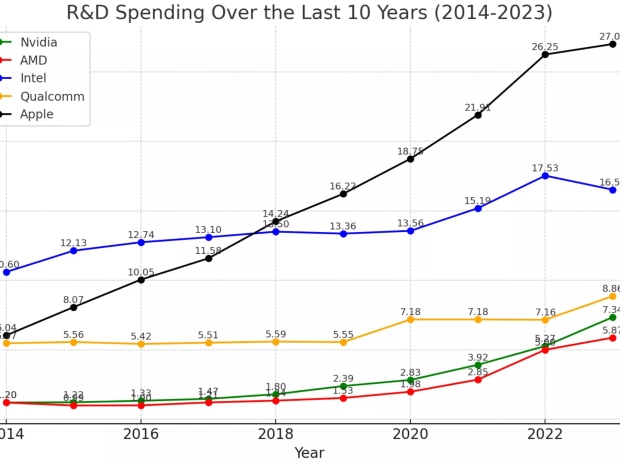According to Tech Fund's analysis of R&D expenditures over the past decade, Nvidia now spends twice as much as AMD. In 2013, their R&D budgets were roughly equal, but Nvidia's has since surged to approximately $12 billion, while AMD's has grown to around $6 billion.
Nvidia focuses nearly all its R&D efforts on artificial intelligence (AI), while AMD's smaller budget is spread across GPUs, CPUs, AI, and FPGA chips.
Although AMD has made impressive gains in the CPU market, with recent generations of its CPUs soundly defeating Intel, it continues to struggle against Nvidia in the GPU sector. Intel, meanwhile, faces endless trouble in CPUs, GPUs, and other areas despite outspending Nvidia and AMD by a wide margin.
According to Tom's Hardware, Intel allocated $16 billion to R&D in 2023 – double the combined budgets of Nvidia and AMD. For 2024, the company projects R&D, market growth, and acquisition costs will range between $17 billion and $20 billion. These funds are spread across diverse ventures, including CPUs, GPUs, quantum computing, and foundries, with significant hopes pinned on its forthcoming 18A process node.
Despite this hefty investment, Intel's market capitalisation hovers around $107 billion, ranking 160th globally. In contrast, AMD ranks 45th with a valuation of $229 billion, more than twice that of Chipzilla's. With its near-total devotion to AI, Nvidia has entered the $3 trillion club and is vying with Apple for the title of the world's most valuable company.
Nvidia's meteoric rise is striking compared to Apple's R&D spending. Job’s Mob spent $27 billion on R&D in 2023 and $31 billion between September 2023 and September 2024.
While some predict the eventual collapse of the AI bubble, which could bring Nvidia back to Earth, there are no immediate signs of such a downturn.




